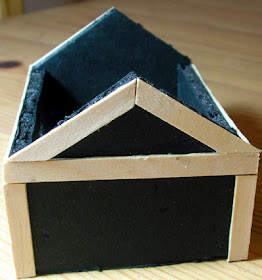Some time later I decided to have a go at building one based on the plans.
Stage One: Marking and Cutting
Because my printer is cleverer than what I am I found myself unable to print out the original plans at the right size.
So I re-drew them on to graph paper.
I then used pins pushed through the plan at significant points to transfer the design onto some foamcore. Then it was easy to simply join the dots and cut out the pieces.
Note mistakes I made when copying the design. Doh!
I took the four pieces I'd cut out and glued them together using PVA and shoved pins through to hold it all in place while it dried. I made sure it was all square by using the squares on my cutting mat.I left it to dry over night.
Pins courtesy of the current Mrs Tom's Toy Soldiers.
Make sure the side walls are inside the end ones, otherwise your roof won't fit!
Stage Three: Wooden frame
For that authentic hovel look you need a timber frame around your building. You could use balsa, but I chose to use coffee stirrers which are free from all major coffee shops (though you may need to buy a coffee). They're about the right size and thickness and easy to use. I chopped them to size and glued them in place with PVA. I made sure they fitted by measuring against the actual model, rather than the plans.
The original plans call for a seperate lintel above the door, but because stirrers are a bit on the thick side I just used the main beam as a the door lintel.
Stage Three: Wooden frame
For that authentic hovel look you need a timber frame around your building. You could use balsa, but I chose to use coffee stirrers which are free from all major coffee shops (though you may need to buy a coffee). They're about the right size and thickness and easy to use. I chopped them to size and glued them in place with PVA. I made sure they fitted by measuring against the actual model, rather than the plans.
The original plans call for a seperate lintel above the door, but because stirrers are a bit on the thick side I just used the main beam as a the door lintel.
Stage Four: Roofing
To keep out the inclement Dark Age weather conditions you need a roof. This was simple cereal packet card, glued in place with PVA and pinned. Leave a small lip overhanging all round the building.
Stage Five: Thatching
I used a flannel I bought from ASDA for the purpose of thatching. I cut it into strips and glued them down with PVA and then soaked them in PVA and brushed downwards to get the "thatch" lying in the right direction. This was a pain in the behind as it happens and I think I shall invest in some teddy bear fur for future roofing, it looks better and is I suspect easier to cut and use.
Sorry for the wonky picture lightness. The sun came out.
Stage Six: Wattle and daubing
I coated the exposed walls in a mixture of PVA, filler, very fine sand and water. Don't ask me the ratios, it was "a bit of this and a dab of that" until I got a runny but sticky consistency I could paint onto the walls.
The white on the thatching is dried PVA
I also added a door cut from balsa at this stage. I scored the balsa to give the impression of planking
Stage Seven: Base Coating
Then it was a case of splashing on some colour
Thatch: Calthan Brown
Walls: Deneb Stone
Wood: Charadon Granite
Stage Eight: Overbrushing
Both wood and thatching got a heavy overbrush:
Wood: Graveyard Earth
Thatching: Khemri Brown
Stage Nine:Drybrushing
A final drybrush to finish off.
Walls: Skull White
Wood and Thatching: Bleached Bone
Subsidence was a common problem in the Early Medieval period
Gripping Beast and Musketeer models for scale.
I'm very happy with the result. It looks the part and has a small enough footprint to not dominate the gaming table. Thanks to the Nothelm chaps for the plans. I think I'll make a couple more of these to complete my Saxon village .







































Nice work!
ReplyDeleteChristopher
Worked out really well. I like the way the thatching has come out.
ReplyDeleteWell done looks great. I too roughly followed the plan for this building on my blog as well.
ReplyDeleteGreat looking blog as well.
Nice little tutorial
ReplyDeleteCheers
paul
Nice little building and good tutorial. Thanks for posting.
ReplyDeleteI think your flannel looks better than teddy bear fur. Never been that convinced by TBF!
ReplyDelete